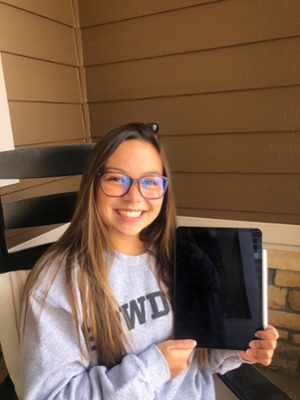Online Teaching: Real-time Data, Real-life Issues
By Tom PorterBowdoin News is publishing a series of stories about online classes, offering a glimpse into how faculty, staff, and students are adapting to the challenges of teaching and learning during a pandemic.
Dave Carlon would like us to meet the BOSS, or the Bowdoin Ocean Sensor System, to give its full title. Purchased two years ago with a grant from the National Science Foundation, the BOSS is arguably the most accurate system out there for measuring the conditions of the ocean, says Carlon. The biology and environmental studies professor is standing at the end of the research pier at the Schiller Coastal Studies Center, where he is director.



This semester, Carlon is teaching Coral Reefs in the Anthropocene (BIOL 2311/ENVS 2211), a new course examining the multiple threats facing coral reefs, including those caused by changing oceanic conditions. The BOSS, along with the Experimental Seawater Laboratory (ESL) a few yards up the hill from the pier, provides essential support for students taking that class, all of whom are doing it remotely due to pandemic-induced restrictions.
The students may be not by physically present, he says, but the data and the experiments are real. “The BOSS measures carbon dioxide in the ocean, as well as oxygen and PH levels,” he explains. “It takes technical expertise and money to maintain a system like this.” With sensors at both ends of the pier, the BOSS samples seawater and measures a range of physical and biological variables every second. Those measurements are uploaded to a constantly updating website, enabling Bowdoin students to access a stream of live data.
After going through the BOSS, the ocean water is then pumped up into tanks at the ESL, another relatively new addition to the Center, funded by the same NSF grant. In these tanks are coral samples from the Gulf of Maine, all of which will be subjected to artificially changing conditions.
Carlon runs the lab, with the help of support technician Heidi Franklin, but much of what goes on in the lab is the responsibility of the students, who meet for synchronous lessons twice a week. “Working together, the class designs the experiments, tinkering with factors like the temperature, salinity, and acidity of the seawater and studying the effect on the coral.”
There are chilling tubes, heaters, and devices for bubbling in CO2, all regulated by several small computers. All these data are uploaded to a website for the students to analyze. They then work on predictive models for the years to come, all of which point to a continuing decrease in PH levels and increase in acidity. It’s not known what the exact effect of ocean acidification will be on coral reefs, says Carlon, but it’s likely to pose a threat by weakening their ability to grow, while warmer waters also cause them to them to expel their symbiotic algae, or bleach.
An important factor in the accuracy of these experiments, he stresses, is the availability of precisely measured control samples taken by the BOSS down at the research pier, as well as other sampling stations out in the gulf. The Gulf of Maine is the fastest warming body of water on the planet, Carlon points out, which makes it a good starting point to study the effects of the changing ocean on various forms of marine life.

A Student’s Perspective: Peyton Tran ’23
“I chose Professor Carlon's class about coral reefs because I wanted to take another biology course, and something I was super excited about when I came to Bowdoin was the marine science classes and the opportunity to be close to the ocean,” says Tran.
“Although we haven’t been able to be physically present at the Schiller Center this semester, the class has been fascinating, and Professor Carlon has been great about being available outside of class for questions and great at communicating his expectations to the students.”
Tran says a big factor in making this remote experience a positive one is the technological support given by the College. Like all Bowdoin students, she has been issued an Apple iPad Pro, which features a keyboard, an Apple Pencil 2 for drawing and writing, and a trackpad, as well as built-in cellular internet for students who need it. “I’ve found the iPad incredibly helpful for remote learning,” she adds. “Not only from an organizational perspective with taking notes, but also to have something tangible in my hands while I learn. It's one thing to type my notes and learn electronically that way, but to be able to physically write my notes and draw pictures and have them translated so well online has been much more helpful than I expected.”